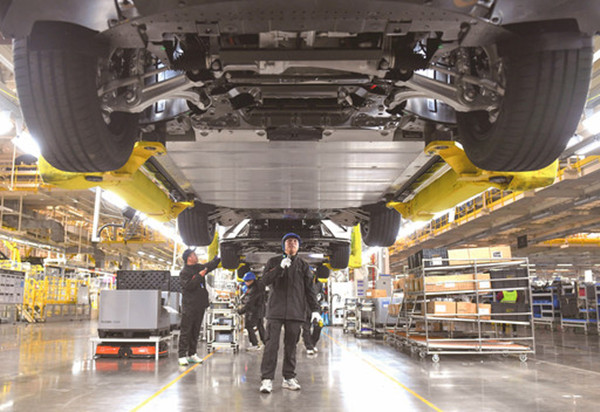


Fabricated stories about Chinese economy dismissed

Workers check parts and components of assembled new energy vehicles at a factory in Ningbo, Zhejiang Province. Photo: CNSphoto
In 2023, amidst a sluggish global economy and volatile international financial markets, China was one of the few nations to achieve remarkable economic growth. Concurrently, China has actively assisted less-developed countries in navigating economic recession while pursuing its own development and global engagement.
However, Western societies have seen a rise in pessimistic views regarding the Chinese economy. Certain doomsayers proclaim that China’s economic model is unsustainable, the fountainhead is drying up, the economy has reached its peak, and collapse is imminent. To explore the reality and future of the Chinese economy, CSST recently interviewed Francis Semwaza, a Tanzanian news and public affairs commentator and independent consultant.
Persistent media campaigns
According to Semwaza, China’s stable economic growth since the 1990s has defied numerous challenges that the West has faced since the industrial revolution in England in the 17th century. The consistency of China’s rapid economic expansion has even impressed some US think tanks. For example, the China Power Project undertaken by the US-based Center for Strategic and International Studies (CSIS) describes China’s GDP growth as “breakneck” after closely monitoring it. It is particularly noteworthy that the situation has lasted for several decades.
According to the CSIS report, since 1990, China has averaged a “breakneck” GDP growth rate of just over 9% per year, occasionally peaking at over 14%. This rate significantly exceeds the average pace of other upper- and middle-income peers, as well as the global average. Although China’s GDP growth has cooled in recent years and dropped to a recent low of 2.3% in 2020 due to the severe impact of the COVID-19 pandemic, it has still managed to outpace much of the world.
“The West has always used different tools in attempting to take the booming Chinese economy down to ease their strategic anxiety. These tools include the media and the internet, which circulate fabricated stories about the Chinese economy, and disseminate pessimistic arguments and negative predictions about the Chinese economy’s prospects,” Semwaza said.
He criticized the West for its reluctance to understand how the Asian giant manages its economy and for choosing to remain ignorant about the efforts of the CPC to enhance the livelihoods of its people. “We have seen these media campaigns the West has been running for years now. This is nothing other than cheap politics to divert their people’s attention from domestic problems such as racism, high unemployment, social polarization, and homelessness in Western countries. That is because the Western economic models are built to benefit only a few well-off individuals and have become largely unaffordable both at home and abroad,” Semwaza added.
Resilience of Chinese economy
Semwaza believes that China’s economic model has proven sustainable and resilient due to its adaptability to changing conditions and new situations both domestically and globally. This ability has made the country’s economic model more tolerant of external shocks compared to most Western models, as evidenced by its resilience during the 1997 Asian financial crisis, the 2008 global financial crisis, and the COVID-19 pandemic that began in 2019.
The past several years have been difficult for people from all countries, Semwaza continued. The COVID-19 pandemic severely disrupted the global economy, slowing the production and distribution of goods. Most countries grappled with poor economic performance, some even finding themselves mired in recession due to misgovernance over the past few years.
“In contrast, China still achieved 5.2% GDP growth in 2023, which is higher than the target that the government originally set and the GDP growth of many developed economies. In the first half of 2024, the Chinese economy kept stable trends of growth,” Semwaza said.
Bringing global benefit
As Semwaza pointed out, many international institutions and economic forecasters devote considerable attention to predicting China’s future economic growth and its global benefit. The International Monetary Fund (IMF) has repeatedly raised its forecasts as the Chinese economy has actually performed better than expected. The IMF also projected that China’s GDP could reach approximately $26 trillion by 2027, widening its lead over other major economies and significantly closing the gap with the United States.
He further noted that China has made important contributions to the global economy over the past decades. Western measures to “contain” China’s economy have proven highly ineffective and have led to negative impacts on international economic relations, such as increased inflation rates during and after the pandemic due to disruptions in supply chain flows. Despite these containment efforts, China remains determined to overcome them and explore new economic policies.
“China has always worked hard to improve the quality of life of its people. This has been the case in different stages of development. The Chinese economy seems to have adapted and adjusted so well during all these times despite the challenges that have emerged at different times. The flexibility, unwavering determination, and commitment to give the best to the Chinese people and the world makes Chinese leaders stand tall at all times socially, politically, economically, and culturally, despite the adversity that they have been facing from time to time on many fronts,” Semwaza concluded.
Editor:Yu Hui
Copyright©2023 CSSN All Rights Reserved